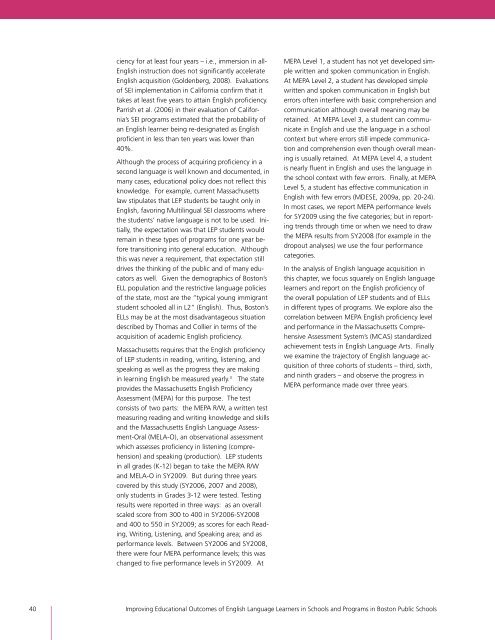Full Report - Center for Collaborative Education
Full Report - Center for Collaborative Education
Full Report - Center for Collaborative Education
You also want an ePaper? Increase the reach of your titles
YUMPU automatically turns print PDFs into web optimized ePapers that Google loves.
ciency <strong>for</strong> at least four years – i.e., immersion in all-<br />
English instruction does not significantly accelerate<br />
English acquisition (Goldenberg, 2008). Evaluations<br />
of SEI implementation in Cali<strong>for</strong>nia confirm that it<br />
takes at least five years to attain English proficiency.<br />
Parrish et al. (2006) in their evaluation of Cali<strong>for</strong>nia’s<br />
SEI programs estimated that the probability of<br />
an English learner being re-designated as English<br />
proficient in less than ten years was lower than<br />
40%.<br />
Although the process of acquiring proficiency in a<br />
second language is well known and documented, in<br />
many cases, educational policy does not reflect this<br />
knowledge. For example, current Massachusetts<br />
law stipulates that LEP students be taught only in<br />
English, favoring Multilingual SEI classrooms where<br />
the students’ native language is not to be used. Initially,<br />
the expectation was that LEP students would<br />
remain in these types of programs <strong>for</strong> one year be<strong>for</strong>e<br />
transitioning into general education. Although<br />
this was never a requirement, that expectation still<br />
drives the thinking of the public and of many educators<br />
as well. Given the demographics of Boston’s<br />
ELL population and the restrictive language policies<br />
of the state, most are the “typical young immigrant<br />
student schooled all in L2” (English). Thus, Boston’s<br />
ELLs may be at the most disadvantageous situation<br />
described by Thomas and Collier in terms of the<br />
acquisition of academic English proficiency.<br />
Massachusetts requires that the English proficiency<br />
of LEP students in reading, writing, listening, and<br />
speaking as well as the progress they are making<br />
in learning English be measured yearly. 3 The state<br />
provides the Massachusetts English Proficiency<br />
Assessment (MEPA) <strong>for</strong> this purpose. The test<br />
consists of two parts: the MEPA R/W, a written test<br />
measuring reading and writing knowledge and skills<br />
and the Massachusetts English Language Assessment-Oral<br />
(MELA-O), an observational assessment<br />
which assesses proficiency in listening (comprehension)<br />
and speaking (production). LEP students<br />
in all grades (K-12) began to take the MEPA R/W<br />
and MELA-O in SY2009. But during three years<br />
covered by this study (SY2006, 2007 and 2008),<br />
only students in Grades 3-12 were tested. Testing<br />
results were reported in three ways: as an overall<br />
scaled score from 300 to 400 in SY2006-SY2008<br />
and 400 to 550 in SY2009; as scores <strong>for</strong> each Reading,<br />
Writing, Listening, and Speaking area; and as<br />
per<strong>for</strong>mance levels. Between SY2006 and SY2008,<br />
there were four MEPA per<strong>for</strong>mance levels; this was<br />
changed to five per<strong>for</strong>mance levels in SY2009. At<br />
MEPA Level 1, a student has not yet developed simple<br />
written and spoken communication in English.<br />
At MEPA Level 2, a student has developed simple<br />
written and spoken communication in English but<br />
errors often interfere with basic comprehension and<br />
communication although overall meaning may be<br />
retained. At MEPA Level 3, a student can communicate<br />
in English and use the language in a school<br />
context but where errors still impede communication<br />
and comprehension even though overall meaning<br />
is usually retained. At MEPA Level 4, a student<br />
is nearly fluent in English and uses the language in<br />
the school context with few errors. Finally, at MEPA<br />
Level 5, a student has effective communication in<br />
English with few errors (MDESE, 2009a, pp. 20-24).<br />
In most cases, we report MEPA per<strong>for</strong>mance levels<br />
<strong>for</strong> SY2009 using the five categories; but in reporting<br />
trends through time or when we need to draw<br />
the MEPA results from SY2008 (<strong>for</strong> example in the<br />
dropout analyses) we use the four per<strong>for</strong>mance<br />
categories.<br />
In the analysis of English language acquisition in<br />
this chapter, we focus squarely on English language<br />
learners and report on the English proficiency of<br />
the overall population of LEP students and of ELLs<br />
in different types of programs. We explore also the<br />
correlation between MEPA English proficiency level<br />
and per<strong>for</strong>mance in the Massachusetts Comprehensive<br />
Assessment System’s (MCAS) standardized<br />
achievement tests in English Language Arts. Finally<br />
we examine the trajectory of English language acquisition<br />
of three cohorts of students – third, sixth,<br />
and ninth graders – and observe the progress in<br />
MEPA per<strong>for</strong>mance made over three years.<br />
40 Improving <strong>Education</strong>al Outcomes of English Language Learners in Schools and Programs in Boston Public Schools


